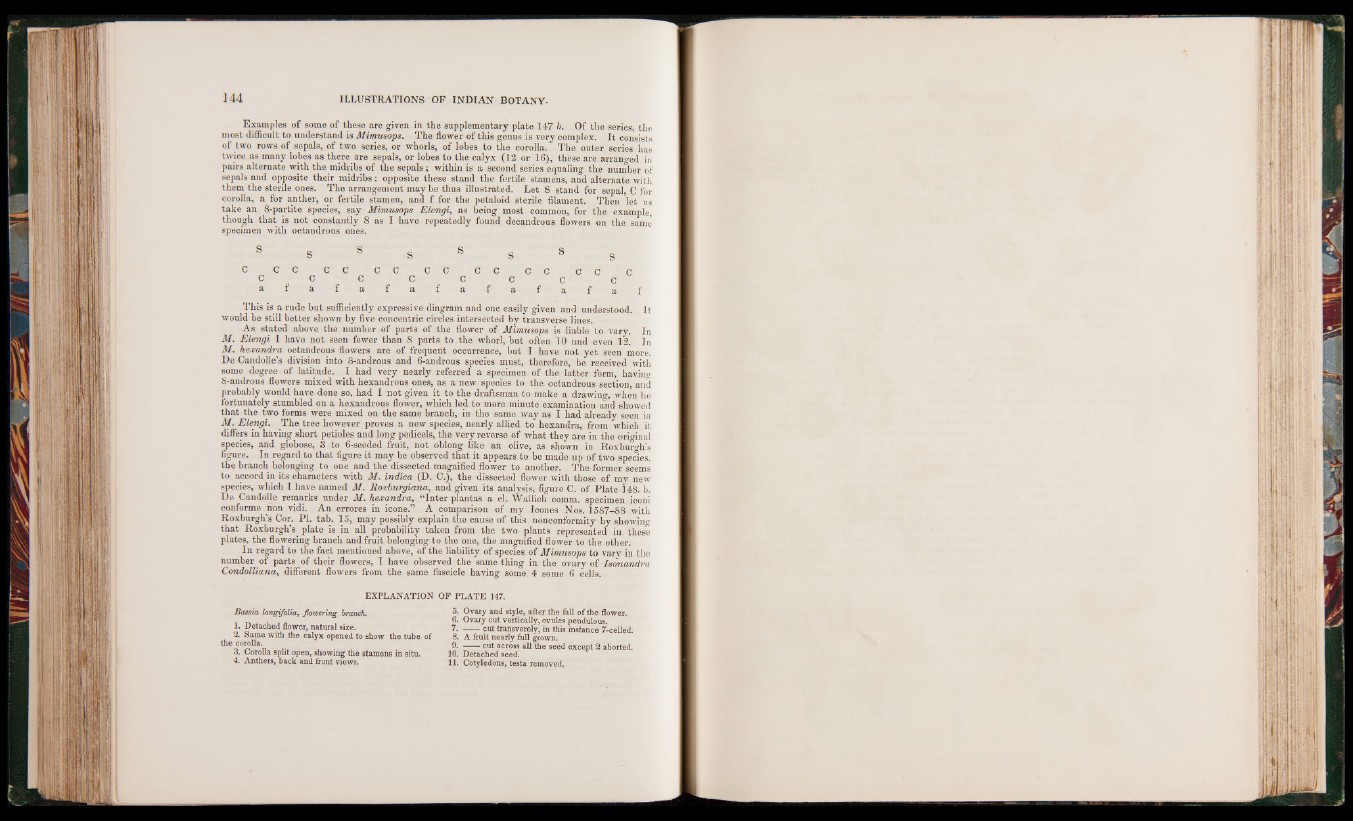
Examples of some of these are given in the supplementary plate 147 b. Of the series, the
most difficult to understand is Mimusops. The flower of this genus is very complex. It consists
of two rows of sepals, of two series, or whorls, of lobes to the corolla. The outer series has
twice as many lobes as there are sepals, or lobes to the calyx (12 or 16), these are arranged in
pairs alternate with the midribs of the sepals ; within is a second series equaling the number of
sepals and opposite their midribs: opposite these stand the fertile stamens, and alternate with
them the sterile ones. The arrangement may be thus illustrated. Let S stand for sepal, C for
corolla, a for anther, or fertile stamen, and f for the petaloid sterile filament. Then let us
take an 8-partite species, say Mimusops Elengi, as being most common, for the example,
though that is not constantly 8 as I have repeatedly found decandrous flowers on the same
specimen with octandrous ones.
s S S S S S S s
c c c c c c c c c c c c c C C C C c c c c c C c a f a f a f a f a f a f a f ia f
This is a rude but sufficiently expressive diagram and one easily given and understood. It
would be still better shown by five concentric circles intersected by transverse lines.
As stated above the number of parts of the flower of Mimusops is liable to vary. In
M. Elengi I have not seen fewer than 8 parts to the whorl, but often 10 and even 12. In
M. hexandra octandrous flowers are of frequent occurrence, but I have not yet seen more.
De Candolle’s division into 8-androus and 6-androus species must, therefore, be received with
some degree of latitude. I had very nearly referred a specimen of the latter form, having
8-androus flowers mixed with hexandrous ones, as a new species to the octandrous section and
probably would have done so, had I not given it to the draftsman to make a drawing when he
fortunately stumbled on a hexandrous flower, which led to more minute examination and showed
that the two forms were mixed on the same branch, in the same way as I had already seen in
M. Elengi. The tree however proves a new species, nearly allied to hexandra, from which it
differs in having short petioles and long pedicels, the very reverse of what they are in the original
species, and globose, 3 to 6-seeded fruit, not oblong like an olive, as shown in Roxburgh’s
figure. In regard to that figure it may be observed that it appears to be made up of two species,
the branch belonging to one and the dissected magnified flower to another. The former seems
to accord in its characters with M. indica (D. C.), the dissected flower with those of my new
species, which I have named M. Roxburgiana, and given its analysis, figure C. of Plate 148. b.
De Candolle remarks under M. hexandra, “ Inter plantas a cl. Wallich comm, specimen iconi
conforme non vidi. An errores in icone.” A comparison of my leones Nos. 1587-88 with
Roxburgh’s Cor. PI. tab. 15, may possibly explain the cause of this nonconformity by showing
that Roxburgh’s plate is in all probability taken from the two plants represented in these
plates, the flowering branch and fruit belonging to the one, the magnified flower to the other.
In regard to the fact mentioned above, of the liability of species of Mimusops to vary in the
number of parts of their flowers, I have observed the same thing in the ovary of Isonandra
Condolliana, different flowers from the same fascicle having some 4 some 6 cells.
EXPLANATION OP PLATE 147.
JBassia longifolia, flowering branch.
1. Detached flower, natural size.
2. Same with the calyx opened to show the tube of
the corolla.
3. Corolla split open, showing the stamens in situ.
4. Anthers, back and front views.
5. Ovary and style, after the fall of the flower.
6. Ovary cut vertically, ovules pendulous.
7 . --------------------- cut transverely, in this instance 7-celled.
8. A fruit nearly full grown.
9 * ------ cut across all the seed except 2 aborted.
10. Detached seed.
11. Cotyledons, testa removed.